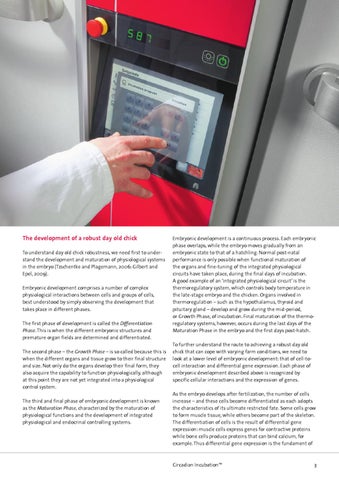The development of a robust day old chick To understand day old chick robustness, we need first to understand the development and maturation of physiological systems in the embryo (Tzschentke and Plagemann, 2006; Gilbert and Epel, 2009). Embryonic development comprises a number of complex physiological interactions between cells and groups of cells, best understood by simply observing the development that takes place in different phases. The first phase of development is called the Differentiation Phase. This is when the different embryonic structures and premature organ fields are determined and differentiated. The second phase – the Growth Phase – is so called because this is when the different organs and tissue grow to their final s tructure and size. Not only do the organs develop their final form, they also acquire the capability to function physiologically, although at this point they are not yet integrated into a physiological control system. The third and final phase of embryonic development is known as the Maturation Phase, characterized by the maturation of physiological functions and the development of integrated physiological and endocrinal controlling systems.
Embryonic development is a continuous process. Each embryonic phase overlaps, while the embryo moves gradually from an embryonic state to that of a hatchling. Normal post-natal performance is only possible when functional maturation of the organs and fine-tuning of the integrated physiological circuits have taken place, during the final days of incubation. A good example of an ‘integrated physiological circuit’ is the thermoregulatory system, which controls body temperature in the late-stage embryo and the chicken. Organs involved in thermoregulation – such as the hypothalamus, thyroid and pituitary gland – develop and grow during the mid-period, or Growth Phase, of incubation. Final maturation of the thermoregulatory systems, however, occurs during the last days of the Maturation Phase in the embryo and the first days post-hatch. To further understand the route to achieving a robust day old chick that can cope with varying farm conditions, we need to look at a lower level of embryonic development: that of cell-tocell interaction and differential gene expression. Each phase of embryonic development described above is recognized by specific cellular interactions and the expression of genes. As the embryo develops after fertilization, the number of cells increase – and these cells become differentiated as each adopts the characteristics of its ultimate restricted fate. Some cells grow to form muscle tissue, while others become part of the skeleton. The differentiation of cells is the result of differential gene expression: muscle cells express genes for contractive proteins while bone cells produce proteins that can bind calcium, for example. Thus differential gene expression is the fundament of
Circadian Incubation™
3
